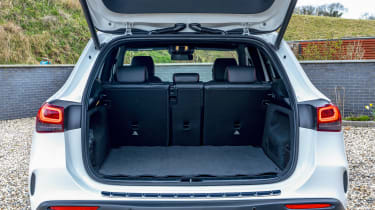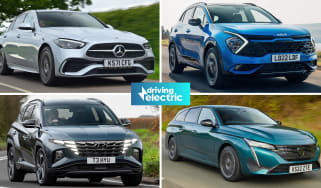Mercedes EQA review: boot space, seating & practicality
Cabin space is strong, but the Mercedes EQA's boot is on the small side – both compared to the petrol GLA and fully electric rivals
| Length | Width | Height | Boot volume (seats up/down) |
|---|---|---|---|
| 4,463mm | 2,020mm | 1,624mm | 340/1,320 litres |
What Mercedes gives with one hand, it takes with the other. The EQA feels pretty spacious inside, both up front and in the rear, but the trade-off is a small boot with very little in the way of cable storage under the floor. The rear seats are fixed, too, so there’s no option to increase boot space by pulling the bench forward.
Still, at least there’s no load lip, and the seats fold pretty much flat with no step, making it easier to load longer items. Size-wise, the EQA is slightly longer but marginally narrower than a Volvo XC40. Much like the petrol GLA, the EQA actually looks pretty compact in the metal, but recognisably different in its design.
Mercedes EQA interior space, storage & comfort
Given the usual constraints of packaging the electric motor, battery and associated hardware, the EQA feels reasonably spacious inside. There’s enough room for six-foot-tall adults to sit in the back, for example, and while there is a transmission tunnel running the length of the car, it’s not overly intrusive. Passengers may find they’re forced to sit with their knees quite high, though, as the battery is mounted under the floor.
Regardless, you also get USB-C ports in the back, plus door bins capable of carrying small water bottles. There’s a central armrest that folds down to reveal a pair of cupholders, too.
Boot space
One area where the EQA does suffer is when it comes to boot space, and this is largely due to packaging. Basing this car on a petrol-engine platform makes fitting the batteries and motors a little tricky; where the GLA offers a usable 495-litre boot, the EQA’s 340-litre maximum falls short. There’s little excuse either – the Volvo XC40 Recharge has a 413-litre boot, while the new BMW iX1 (also based on a petrol car) boasts a whopping 490 litres with the rear seats in place. Both are quite a bit more practical than the miniature Mercedes.
You can fold the EQA’s seats down, of course, opening up a more generous 1,320 litres, measured up to the roof. Cable storage? That’s not great, though there is space for one of the leads under the boot floor – just be sure which one you will or won’t need before setting off.




